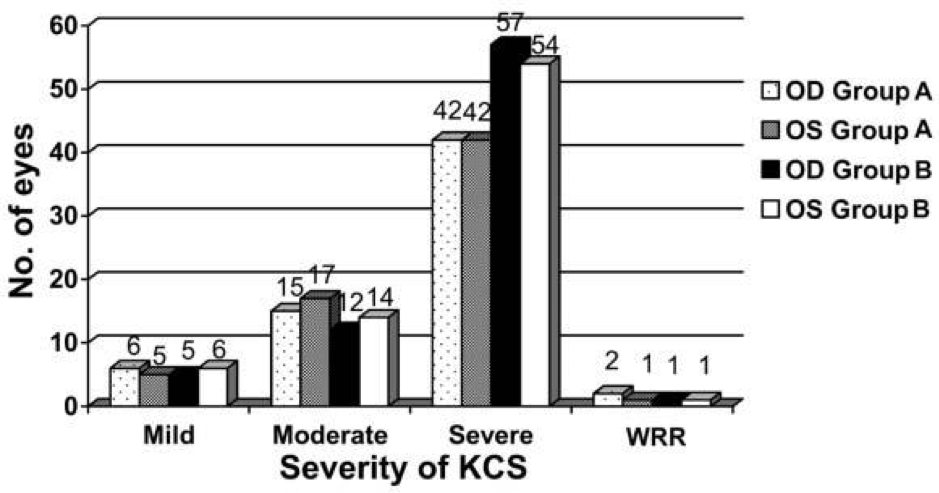エトドラクの投与に関連した犬の乾性角結膜炎:211例(1992-2002)
Keratoconjunctivitis sicca associated with administration of etodolac in dogs: 211 cases (1992-2002)
エトドラクの投与に関連した犬の乾性角結膜炎:211例(1992-2002)
Klauss G, Giuliano EA, Moore CP, et al. Keratoconjunctivitis sicca associated with administration of etodolac in dogs: 211 cases (1992-2002). J Am Vet Med Assoc. 2007;230(4):541-547. doi:10.2460/javma.230.4.541 / PMID: 17302553
論文アブストラクト(PubMed)はこちら
[su_service title=”論文アブストラクト” icon=”icon: book” size=”18″][/su_service]
[su_tabs][su_tab title=”原文” disabled=”no” anchor=”” url=”” target=”blank” class=””]
OBJECTIVE:
To characterize features and response to treatment of keratoconjunctivitis sicca (KCS) associated with oral administration of etodolac in dogs.
DESIGN:
Retrospective case series.
SAMPLE POPULATION: 65 cases obtained from a survey of veterinary ophthalmologists (group A) and 146 cases reported to Fort Dodge Animal Health (group B).
PROCEDURES:
Data analyzed included breed, sex, age, weight, dose and duration of etodolac administration, results of Schirmer tear test at the time of diagnosis and last follow-up, treatments, and response to treatments. Groups A and B were analyzed separately by use of forward stepwise logistic regression models developed to predict probability of complete remission or clinical improvement as a function of several variables.
RESULTS:
Most dogs developed severe KCS (84 eyes of 50 dogs [group A]; 111 eyes of 62 dogs [group B]). Resolution of KCS occurred in 7 of 65 (A) and 23 of 146 (B) dogs. No response to treatment was observed in 26 of 65 (A) and 27 of 146 (B) dogs. Fifty-one (A) and 52 (B) dogs had records that were sufficiently complete to use in models. In group B, dogs with etodolac treatment intervals < 6 months prior to the onset of KCS were 4.2 times as likely to have remission as were dogs with treatment intervals > or = 6 months.
CONCLUSIONS AND CLINICAL RELEVANCE:
Shorter duration of etodolac administration (< 6 months) was associated with improved outcome in 1 population of dogs. Monitoring of tear production should be considered prior to and during administration of etodolac in dogs.
[/su_tab][su_tab title=“翻訳” disabled=”no” anchor=”” url=”” target=”blank” class=””]
目的:
エトドラクの経口投与に関連した犬の乾性角結膜炎(KCS:keratoconjunctivitis sicca)の特徴および治療に対する反応を調べること
デザイン:
レトロスペクティブ・ケースシリーズ。
サンプル集団:
獣医眼科医の調査から入手した65例(グループA)とフォートダッジアニマルヘルスに報告された146例(グループB)
方法:
分析したデータには、品種、性別、年齢、体重、エトドラクの投与量および投与期間、診断時および最終再診時のシルマー涙液試験の結果、治療および治療に対する反応が含まれた。グループAとBは、いくつかの変数の関数として完全寛解あるいは臨床的改善の可能性を予測するために開発された変数増加ロジスティク回帰モデルを使用し、個別に分析した。
ほとんどの犬が重度のKCSを起こした(犬50頭の84眼[グループA]、62頭の111眼[グループB])。65例中7例(A)と146例中23例(B)ではKCSが改善した。 65例中26例(A)と146例中27例(B)では治療に対する反応が観察されなかった。犬51頭(A)と52頭(B)は、統計モデルへの使用に十分に完全な記録を持っていた。グループBでは、KCS発症前のエトドラクによる治療期間が6ヶ月未満であった犬が寛解する可能性は、6ヶ月以上であった犬の4.2倍であった。
結論と臨床的意義:
犬の1つの母集団において、エトドラクの投与期間が比較的短い(<6カ月)ことは、転帰が改善することと関連していた。犬にエトドラクを投与する前と投与している間は、涙液産生のモニタリングを考慮すべきである。
[/su_tab][/su_tabs]

発症すると約半数で重度のKCSを認める。(Figure 2 より)
